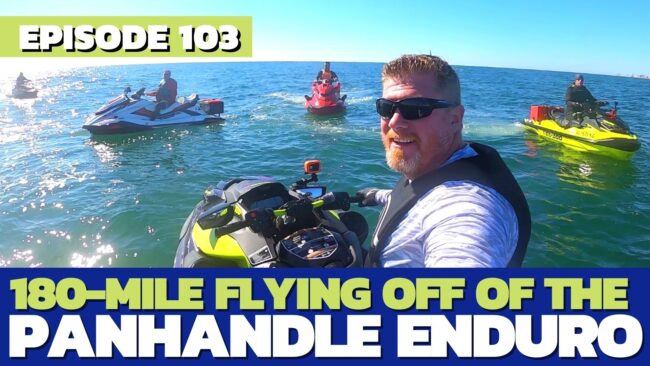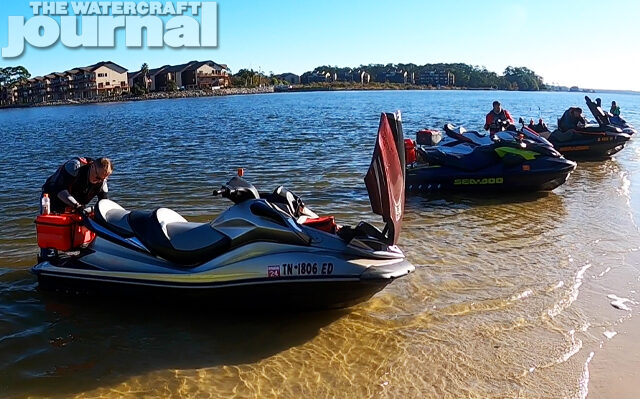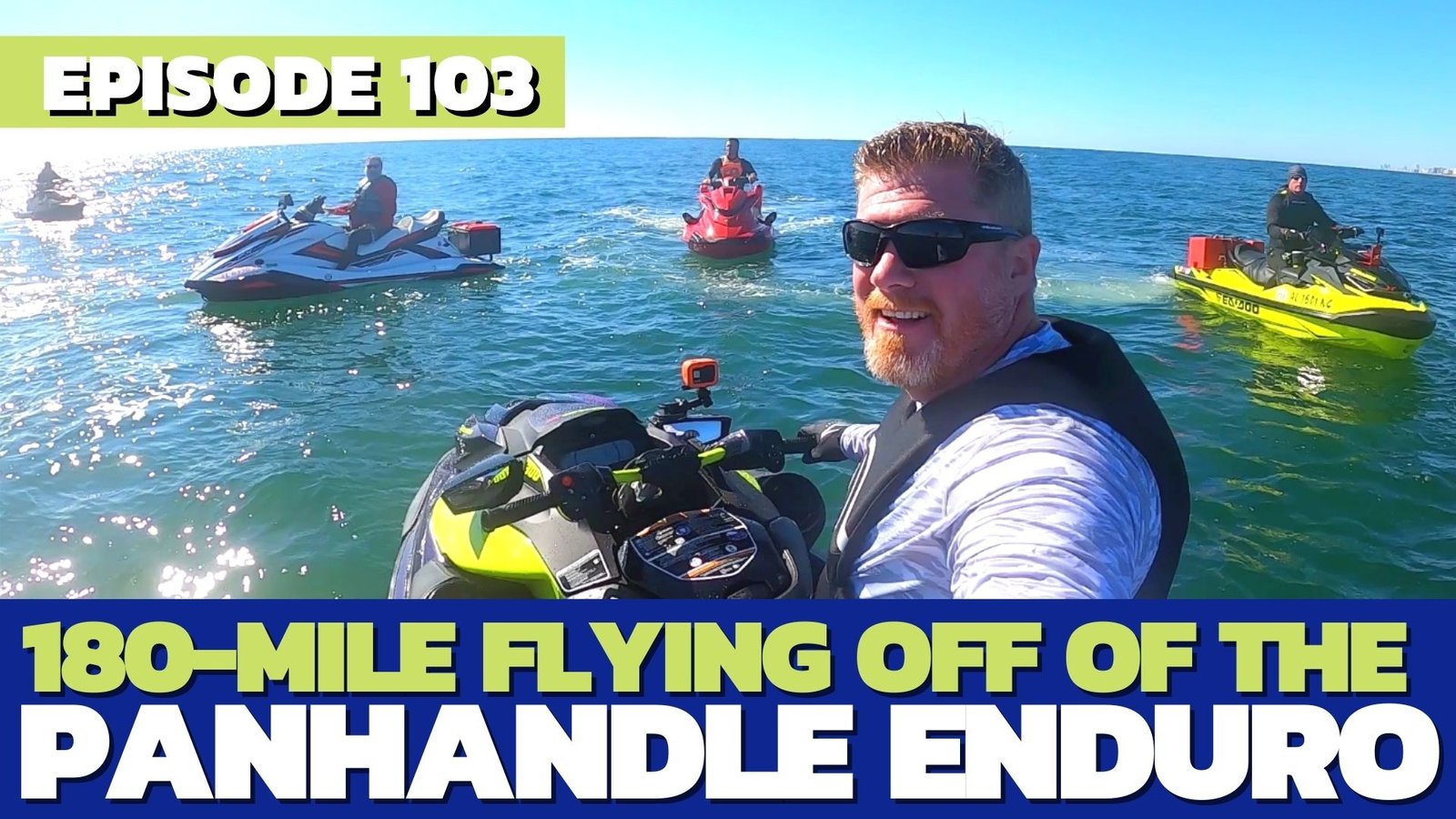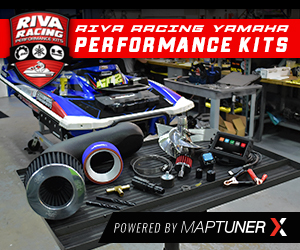[What you’re going to read is both the script from the official recap video attached at the end of this article, as well as some added details and notes that have come to this author after almost two months of contemplation. –K]
The idea was pretty simple – at least in my head it was. Drawing from my years of racing watercraft offshore (most of it being out in the open Pacific Ocean), I wanted to encourage a select group of like-minded lunatics to push themselves and their watercraft just a little further and harder than they would normally go on a run-of-the-mill adventure ride.
And no, I wasn’t just talking about racking up a bunch of miles – although, that was certainly part of the plan – but also traverse a variety of water conditions all in the same day. The biggest question on my mind was whether I could find a route that would challenge our group in such a way? Thankfully, it didn’t take long for a few others in the Panhandle PWC Facebook group to join my quest.
Within a day, Alabama local Brad Bertrand jumped right in, sending me a private message. The route he had logged in his GPS was simple enough: starting in the bayou of Satsuma, Alabama, we’d cut southeast through Mobile Bay and then hang a hard left towards Orange Beach. From Orange Beach, we’d follow the Intercoastal past Pensacola all the way to Destin and circle back.
In all, the total proposed mileage was well over 250 miles with hopes that with enough time, the route would allow us to swing out into the open gulf and try our hand at some offshore riding, which I was craving. The final caveat to my idea was that I wanted reduce the fuel stops, pushing them longer apart. This would force everyone to bring extra fuel. Extra fuel meant no prolonged stops and it also implied a little bit of danger – which is key to a ride like this.
In preparation, I had equipped The Watercraft Journal’s 2021 Sea-Doo RXP-X 300 with a prototype LinQ mount-equipped stainless steel rack from Kool PWC Stuff that I had rattle-canned black (with some old rollbar paint I had in the garage) and a pair of brand new 5-gallon Sure Cans. When tipped up, I can squeeze in quite a bit more than the advertised 5-gallons (more like 6), so I carried an extra 12-gallons in back.
With Brad established as our group leader and lead navigator, the next step was letting folks know about it. That part was pretty easy, given The Watercraft Journal’s half million readers and 1.8 million annual YouTube views. So it didn’t take long for word to get out, but as much as excited riders began signing up, the complainers came pouring in. “Why are you going so fast?” “Why do I need to bring extra gas?” Blah, blah, blah. These were exactly the kind of folks I didn’t want. These guys were tourists and I wanted adventurers.
That November morning in Satsuma was foggy, like really foggy. The twist and turns of the bayou just above Mobile Bay wasn’t wasn’t too technical, but heavy fog lit by the piercing sunrise made visibility a little difficult (almost nil). Most of us had seen worse, but our group of nine wasn’t the fine-tuned platoon I had hoped for, and the route would quickly begin to weed out the ranks. Admittedly, I felt a little like Lee Marvin looking over his Dirty Dozen for the first time.
Passing below a couple of train trestles, we sprung out into the Bay into mild conditions. Brad and his ’19 Sea-Doo RXT-X 300 rose up to a steady low-60 mile per hour clip and I aboard the RXP-X 300 paced alongside him. A little far off, a bright red Yamaha VXR streaked across the windblown chop. Tony Dalton wasn’t going to be outpaced by us, supercharger or not, and proved that he was no wilting flower. (More on that later.)
Per Brad’s direction, the route southeast through Mobile Bay smoothed a little once we passed the halfway point. Brad led us to a small sandbar at the mouth of the river where we could regather our group. “Ten minutes everyone,” Brad commanded, tapping his watch. AS the rest of the group pulled up to the beach, I could tell things were off. One rider on a 10-year-old Ultra 300LX was losing this auxiliary fuel tank, the adjustments having backed off.
Another rider had lost both of his jerry cans, having used a single loose-fitting bungee cord to secure his 50-something-pounds of extra fuel. The bemoaning was in full swing and plans were made to escort a few back to the launch. I wanted to reach Destin, and these setbacks were going to cost us dearly.
“Well, hold on. I’ve got plenty of extra fuel,” one rider paused, patting the hood of his Yamaha VX Cruiser HO. “She’s not real thirsty. I’ll help anyone out who needs gas. So let’s go to LuLu’s and see if they’ve got extra fuel cans. Otherwise, I can still help.”
LuLu’s in Gulf Shores wasn’t too far away and we could make it fine, even if some skis’ Low Fuel alarms had started to chime already. So off we went. While this stop was supposed to be for just one rider, I foolishly pulled up and topped off my tanks. The rest of the crowd followed my example, none of us realizing that the prolonged delay would completely cost us the Destin route.
Once I paid my tab, I idled from the dock up to Brad, who shook his head at me, “We ain’t gonna make the big route now,” he said, pointing at his watch. This unscheduled stop ate up waaay too much time.
Leaving the No Wake Zone and speeding up to Orange Beach, our pace was taking too long and it being winter, meant we didn’t have too much daylight to spare. During another prolonged No Wake Zone, as we passed million dollar yachts, Brad suggested: “Let’s skip Destin. How about we hop out into the gulf just outside of Pensacola and ride back through the surf all the way to Orange Beach for lunch? It should be pretty challenging.”
I nodded in agreement and followed Brad’s bright yellow Sea-Doo all the way to our originally-planned-for first fuel stop. A few of us needed to splash a few gallons in, most just wanted to stretch their legs. From there, I tailed Brad into the whitecaps of the open gulf. A chilled blast of salt water against my face was all I needed to remember what we were in for.
Even trimmed to its upmost hilt, the RXP-X torpedoed nose first into the surf. It’s aggressive keel ruddered in the water, twisting and contorting in the wind-blown wash. That’s what caused me to sit for nearly half of our time in the gulf (against my natural tendency to stand). Standing noticeably altered the ski’s center of gravity, so sitting seemed to make it happier.
Pacing well ahead of our pack, I figured I didn’t need to charge to so hard, so I opted to pull deep into Brad’s whitewash and ride his foam for a few miles. (It’s an old trick for ocean riding, but you’ve got to pay attention so you don’t park your ski on to your buddy’s backseat.) The RXT-X didn’t track much better than the RXP-X but the two of us made a brightly hued pair for the rest to follow.
Twice we stopped to gather our troops; the beating having loosened equipment and racks. Readjustments were made, gas cans emptied were into fuel tanks to relieve a little weight from off of the transom. Some complained, but others cracked wise and prodded the others to keep pushing. They say “a bitching Marine is a happy Marine” so the grumbles were expected.
The high bridge stretching over Perdido Pass was our gateway into Orange Beach, Alabama. We idled under its shade and into the smooth breakwater until reaching Pirates Cove in Elberta. The themed beach resort was a welcome respite but as Brad had noted, yet another distraction from us racking up the kinds of miles we had hoped for originally.
Leaving Pirate’s Cove refreshed and recharged, it was a straight shot back through the Alabama Coastal Connection to the mouth of Mobile Bay. We pinned the throttles hard and let the supercharged Sea-Doos howl. Being weighed down with fuel and gear, the RXP-X climbed just over 70mph. With the jerry cans dry and the belly tank low, she’d hit 74 easy.
Reaching the marker, we came to a stop at LuLu’s and waited for the rest of the group. Miles behind us, the slow moving barge that Brad and I had slipped past without any trouble had kicked up a heck of a fantail – and ejected Tony Dalton and his red VXR several feet in the air.
Either somehow failing to read the water or gauge his speed, Tony launched hard and came down hard on the rail, splitting his forehead. Thankfully, the rest of the group gathered around Tony as he swam back and remounted his Yamaha. With his bell sufficiently rung, Tony and the group idled up to the fuel dock at LuLu’s and took a breather.
There, Brad pointed a heavy finger at his GPS and motioned me over. “The day’s pretty much over,” he explained. “We’ve got to cross the bay back into the bayou, but from there, we’re pretty much done.” Brad suggested we take a few paths through the swamp to rack up some final miles and give the guys something fun to speed on. I liked the idea and readied for the final bit of rough water the afternoon’s bay had in store for us.
Like an inverse of the morning’s conditions, the southern half of the bay was chewed up, it’s flat shallow bottom bouncing up an arrhythmic water surface of white caps and off-tempo waves. And just like in the morning, once we broke pass the half-way marker, Point Clear the wind direction radically changed the water’s surface and caused it to lay down.
Suddenly, the rhythm of the mild waves kept the beat with the staccato of the Sea-Doo’s hull, and 70 miles per hour never felt more natural. Brad, Tony and I pinned the final 20-miles of Mobile Bay hoping that those behind us found their rhythm as well (thankfully some did, but others struggled after a long day of riding).
The flat, muddy waters pouring into the bay from the bayou beckoned for us to mash the gas and race inside. Brad had a winding path logged in his GPS that took us north into the Apalachee and Tensaw Rivers. We raced passed cypress trees dripping heavy Spanish moss, careened through winding natural race courses and cut up the glassy water as a sort of celebration after the day’s ride.
In all, we racked up 179 miles – just shy of 180. We ate up over 40 miles of churned up bay chop, blasted over 100 miles of flat briny glass, and battered our way over 24 miles over open gulf white caps, with a good mix of stuff in between. It was a great day full of ups and downs, and a big dollop of disappointment – but we still managed an awesome ride.
Rides like these always require a Plan B and gratefully, Brad was the type of group leader who came equipped with half a dozen contingencies. Maybe I’ll choose to host another one, but you can rest assured I’ll be turning people away at the launch ramp who aren’t prepared to make the full ride. Tools, straps, you name it. We’re not waiting for you, so you best remember your boy scout motto and come prepared.



































